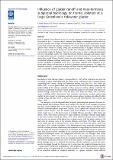Files in this item
Influence of glacier runoff and near-terminus subglacial hydrology on frontal ablation at a large Greenlandic tidewater glacier
Item metadata
| dc.contributor.author | Bunce, Charlie | |
| dc.contributor.author | Nienow, Peter | |
| dc.contributor.author | Sole, Andrew | |
| dc.contributor.author | Cowton, Tom | |
| dc.contributor.author | Davison, Ben | |
| dc.date.accessioned | 2021-01-11T11:30:02Z | |
| dc.date.available | 2021-01-11T11:30:02Z | |
| dc.date.issued | 2020-12-29 | |
| dc.identifier | 272129467 | |
| dc.identifier | aad1fe0b-6047-4bc9-8266-eaf4cf3140da | |
| dc.identifier | 85098696217 | |
| dc.identifier | 000629692500012 | |
| dc.identifier.citation | Bunce , C , Nienow , P , Sole , A , Cowton , T & Davison , B 2020 , ' Influence of glacier runoff and near-terminus subglacial hydrology on frontal ablation at a large Greenlandic tidewater glacier ' , Journal of Glaciology , vol. First View . https://doi.org/10.1017/jog.2020.109 | en |
| dc.identifier.issn | 0022-1430 | |
| dc.identifier.other | ORCID: /0000-0001-9483-2956/work/86538342 | |
| dc.identifier.other | ORCID: /0000-0003-1668-7372/work/86538442 | |
| dc.identifier.uri | https://hdl.handle.net/10023/21257 | |
| dc.description | Charlie Bunce is supported by a NERC DTP studentship (NE/L002558/1). Ben Davison is funded by the Scottish Alliance for Geoscience, Environment and Society (SAGES) and University of St. Andrews. We acknowledge field and research grants from the RGS-IBG postgraduate research fund and Mackay/Weir Greenland Fund (University of Edinburgh) awarded to Charlie Bunce and RGS-IBG postgraduate research fund, Mackay/Weir Greenland Fund (University of Edinburgh) and Centenary Funding (University of Edinburgh) awarded to Alexis Moyer (University of Edinburgh). | en |
| dc.description.abstract | Frontal ablation from tidewater glaciers is a major component of the total mass loss from the Greenland ice sheet. It remains unclear, however, how changes in atmospheric and oceanic temperatures translate into changes in frontal ablation, in part due to sparse observations at sufficiently high spatial and temporal resolution. We present high-frequency time-lapse imagery (photos every 30 min) of iceberg calving and meltwater plumes at Kangiata Nunaata Sermia (KNS), southwest Greenland, during June–October 2017, alongside satellite-derived ice velocities and modelled subglacial discharge. Early in the melt season, we infer a subglacial hydrological network with multiple outlets that would theoretically distribute discharge and enhance undercutting by submarine melt, an inference supported by our observations of terminus-wide calving during this period. During the melt season, we infer hydraulic evolution to a relatively more channelised subglacial drainage configuration, based on meltwater plume visibility indicating focused emergence of subglacial water; these observations coincide with a reduction in terminus-wide calving and transition to an incised planform terminus geometry. We suggest that temporal variations in subglacial discharge and near-terminus subglacial hydraulic efficiency exert considerable influence on calving and frontal ablation at KNS. | |
| dc.format.extent | 10 | |
| dc.format.extent | 813380 | |
| dc.language.iso | eng | |
| dc.relation.ispartof | Journal of Glaciology | en |
| dc.subject | Arctic glaciology | en |
| dc.subject | Ice/ocean interactions | en |
| dc.subject | Iceberg calving | en |
| dc.subject | G Geography (General) | en |
| dc.subject | NDAS | en |
| dc.subject | SDG 14 - Life Below Water | en |
| dc.subject.lcc | G1 | en |
| dc.title | Influence of glacier runoff and near-terminus subglacial hydrology on frontal ablation at a large Greenlandic tidewater glacier | en |
| dc.type | Journal article | en |
| dc.contributor.institution | University of St Andrews. School of Geography & Sustainable Development | en |
| dc.contributor.institution | University of St Andrews. Bell-Edwards Geographic Data Institute | en |
| dc.contributor.institution | University of St Andrews. Environmental Change Research Group | en |
| dc.identifier.doi | 10.1017/jog.2020.109 | |
| dc.description.status | Peer reviewed | en |
This item appears in the following Collection(s)
Items in the St Andrews Research Repository are protected by copyright, with all rights reserved, unless otherwise indicated.

